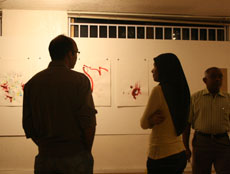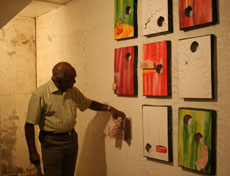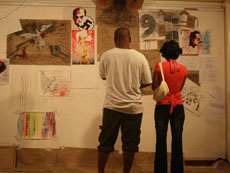How does it feel to have an 8 kilogram lump of dough on your head? The 99 participants of the Dough Portrait series has the answer to that question.
The Dough portraits are the first of their kind to be held in Maldives, features people of all ages and sizes. The one common theme found in the photographs? The lump of dough that covers their faces.
“I wanted to remove the barriers that exist between the person and art,” says Søren Dahlgaard, the artist behind this innovative concept.
A universal medium
Friends and family members of the artist, as well as people who passed in front of the art gallery last year in July, were asked to pose for the portraits.
“I find the process of creating the portraits with the people the most interesting” says Dahlgaard, adding that it’s a very democratic process. Democratic it is – the photos of all those who participated finding a place on the wall of the gallery.
The posers are invited to play with and mold the dough before placing it on their heads.
Some found the dough cold, others say their heads wobbled under the weight of it.
The participants seem to have different reactions to it. Nihama, 24, sits calm and composed, with a lump of dough on her face, as if saying ‘I won’t bat an eyelid.’ Manih,32 is more reflective, doing his own version of David the thinker, a hand holding his dough covered chin. Hassan, 23 and nonchalant, holds a boduberu in his hands, the lengthening dough reaching for it.
“It’s my sculpture material,” says Dahlgaard of the dough, adding that he likes the universality of dough: “Here it’s made into roshi, in Italy it becomes pizza, in India it’s a naan and in France it’s a croissant.”
Sculpture materials like marble and bronze last for 100’s of years, but the dough does not even last a day.
“Photos are also taken quickly as the dough might fall off.”
A question of identity
Some of the earliest paintings were those of portraits commissioned by the rich and the ruling elite, as an everlasting memory.
The focal point of a portrait has always remained the face, with the measure of how good it is being judged by how well an artist can capture the expression or the mood of the person.
Dahlgaard’s photos are a new way of looking at portraits, where the face, the primary identifying feature of a person is hidden.
“The face does not have much to do with the personality, the face is like a mask,” he says.
And yet the mask is not static. The dough changes on 16 year-old Marina’s head, it looks like an inverted bucket with rough edges. On Hajja,21, it seems like a living breathing thing, about to engulf her. On Samfa,63, it seems to mimic her hands, pointing one finger forward.
“The shape always changes, even if you don’t try, the dough moves on its own and changes.”
Just like a face, the way the dough falls seems to give the person a unique identity.
An unusual journey
Like his art, Dahlgaard’s journey to being a full time artist is also unusual. After finishing his studies from the Slade School of Fine Arts in London, Dahlgaard – who comes from Copenhagen in Denmark – spent two years in Maldives doing a pilot project in farming.
“My wife is Maldivian, and I felt my children would benefit from living in the Maldives for a while.”
Realistically, Dahlgaard says he knew that it would not be possible to make a living creating art straight out of art school.
So he grew vegetables in Hibalhidhoo, an uninhabited island in Baa Atoll while nursing a hidden agenda: “I wanted to create an artists-in-residence island.”
He gave up the idea as it needed too high an investment. “But farming was a challenge and needed creativity as in all jobs.”
Dahlgaard moved back to Copenhagen and entered the art scene. His dough portraits were first produced and exhibited in the National Art Gallery in Denmark in 2008, before moving on to Kosovo and Maldives.
The project will move to eight different locations around the world. “I would like to do the dough portraits and cover famous faces of Hollywood.”
Dahlgaard identifies with the Japanese Avante-Garde group Gutai, active in the 1950’s. Their theme of decay and destruction he says “ is only an element in my way of thinking.” It’s more their approach to making art active that is the mainstay of Dahlgaard’s work.” It’s things like running through canvases, throwing paint, the act of reducing the barrier between people and art.”
As such all of Dahlgaard’s work invites participation: “The Breathing Room”, showcased in Rohde Contemporary in Copenhagen and at the Singapore Biennale in 2008, is a white room. A living breathing room – with walls made of soft pvc canvas, it changes into convex and concave shapes mimicking human breathing.
His next project for Maldives involves the famous portrait painter ‘the dough worrier.’ “I’d like to video the dough worrier in a Maldivian island.”
Strapped with 70 baguettes all over his body and face, Dahlgaard is the worrier that pours paint on to a participant, before clicking a photo.
“It’s the frustrated artist, trying to make a masterpiece.”
But before that Maldives will be transported to Denmark. A documentary about Dahlgaard’s brief foray into farming will be showcased in his home country.
In January, when it will be minus 10 degrees in Copenhagen, “the art center is going to be heated to Maldivian temperature and humidity.” Chilli and tomato plants will be grown, while a replica of Dahlgaard’s office will be re-created there.
In Dahlgaard’s world everyday items become part of art, and the viewer is invited to join in instead of looking from afar.
Dough Portraits will be exhibited at the National Art Gallery until August 10, 2010.
NAG will be open on weekdays from 11:00am to 16:00pm and from 20:00pm to 23:00pm.
Likes (1)Dislikes
(1)Dislikes (0)
(0) 


